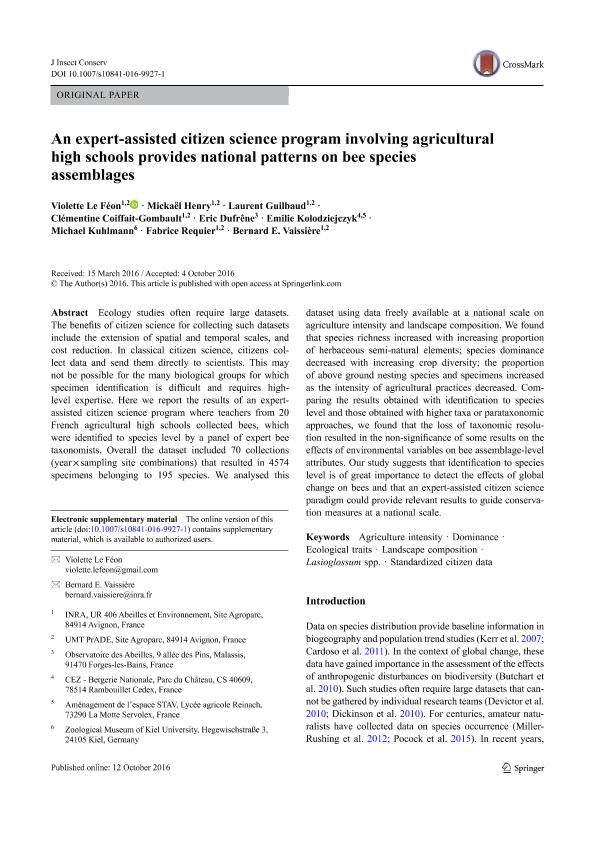Mostrar el registro sencillo del ítem
dc.contributor.author
Le Féon, Violette
dc.contributor.author
Henry, Mickaël
dc.contributor.author
Guilbaud, Laurent
dc.contributor.author
Coiffait Gombault, Clémentine
dc.contributor.author
Dufrêne, Eric
dc.contributor.author
Kolodziejczyk, Emilie
dc.contributor.author
Kuhkmann, Michael
dc.contributor.author
Requier, Fabrice

dc.contributor.author
Vaissière, Bernard E.
dc.date.available
2019-04-17T14:43:16Z
dc.date.issued
2016-10-12
dc.identifier.citation
Le Féon, Violette; Henry, Mickaël; Guilbaud, Laurent; Coiffait Gombault, Clémentine; Dufrêne, Eric; et al.; An expert-assisted citizen science program involving agricultural high schools provides national patterns on bee species assemblages; Springer; Journal of Insect Conservation; 20; 5; 12-10-2016; 905-918
dc.identifier.issn
1366-638X
dc.identifier.uri
http://hdl.handle.net/11336/74553
dc.description.abstract
Ecology studies often require large datasets. The benefits of citizen science for collecting such datasets include the extension of spatial and temporal scales, and cost reduction. In classical citizen science, citizens collect data and send them directly to scientists. This may not be possible for the many biological groups for which specimen identification is difficult and requires high-level expertise. Here we report the results of an expert-assisted citizen science program where teachers from 20 French agricultural high schools collected bees, which were identified to species level by a panel of expert bee taxonomists. Overall the dataset included 70 collections (year × sampling site combinations) that resulted in 4574 specimens belonging to 195 species. We analysed this dataset using data freely available at a national scale on agriculture intensity and landscape composition. We found that species richness increased with increasing proportion of herbaceous semi-natural elements; species dominance decreased with increasing crop diversity; the proportion of above ground nesting species and specimens increased as the intensity of agricultural practices decreased. Comparing the results obtained with identification to species level and those obtained with higher taxa or parataxonomic approaches, we found that the loss of taxonomic resolution resulted in the non-significance of some results on the effects of environmental variables on bee assemblage-level attributes. Our study suggests that identification to species level is of great importance to detect the effects of global change on bees and that an expert-assisted citizen science paradigm could provide relevant results to guide conservation measures at a national scale.
dc.format
application/pdf
dc.language.iso
eng
dc.publisher
Springer

dc.rights
info:eu-repo/semantics/openAccess
dc.rights.uri
https://creativecommons.org/licenses/by-nc-sa/2.5/ar/
dc.subject
Agriculture Intensity
dc.subject
Dominance
dc.subject
Ecological Traits
dc.subject
Landscape Composition
dc.subject
Lasioglossum Spp
dc.subject
Standardized Citizen Data
dc.subject.classification
Otras Ciencias Biológicas

dc.subject.classification
Ciencias Biológicas

dc.subject.classification
CIENCIAS NATURALES Y EXACTAS

dc.title
An expert-assisted citizen science program involving agricultural high schools provides national patterns on bee species assemblages
dc.type
info:eu-repo/semantics/article
dc.type
info:ar-repo/semantics/artículo
dc.type
info:eu-repo/semantics/publishedVersion
dc.date.updated
2019-04-11T19:50:25Z
dc.journal.volume
20
dc.journal.number
5
dc.journal.pagination
905-918
dc.journal.pais
Alemania

dc.journal.ciudad
Berlín
dc.description.fil
Fil: Le Féon, Violette. Institut National de la Recherche Agronomique; Francia
dc.description.fil
Fil: Henry, Mickaël. Institut National de la Recherche Agronomique; Francia
dc.description.fil
Fil: Guilbaud, Laurent. Institut National de la Recherche Agronomique; Francia
dc.description.fil
Fil: Coiffait Gombault, Clémentine. Institut National de la Recherche Agronomique; Francia
dc.description.fil
Fil: Dufrêne, Eric. Observatoire des Abeilles; Francia
dc.description.fil
Fil: Kolodziejczyk, Emilie. Lycée agricole Reinach. Aménagement de l’espace STAV; Francia
dc.description.fil
Fil: Kuhkmann, Michael. Kiel University. Zoological Museum; Francia
dc.description.fil
Fil: Requier, Fabrice. Consejo Nacional de Investigaciones Científicas y Técnicas. Centro Científico Tecnológico Conicet - Patagonia Norte; Argentina. Institut National de la Recherche Agronomique; Francia
dc.description.fil
Fil: Vaissière, Bernard E.. Institut National de la Recherche Agronomique; Francia
dc.journal.title
Journal of Insect Conservation

dc.relation.alternativeid
info:eu-repo/semantics/altIdentifier/doi/http://dx.doi.org/10.1007/s10841-016-9927-1
dc.relation.alternativeid
info:eu-repo/semantics/altIdentifier/url/https://link.springer.com/article/10.1007/s10841-016-9927-1
Archivos asociados
